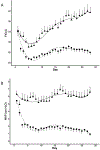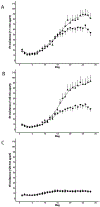Neonatal intermittent hypoxemia events are associated with diagnosis of bronchopulmonary dysplasia at 36 weeks postmenstrual age
- PMID: 30538265
- PMCID: PMC6377834
- DOI: 10.1038/s41390-018-0253-z
Neonatal intermittent hypoxemia events are associated with diagnosis of bronchopulmonary dysplasia at 36 weeks postmenstrual age
Abstract
Background: Bronchopulmonary dysplasia (BPD) is a chronic lung disease and major pulmonary complication after premature birth. We have previously shown that increased intermittent hypoxemia (IH) events have been correlated to adverse outcomes and mortality in extremely premature infants. We hypothesize that early IH patterns are associated with the development of BPD.
Methods: IH frequency, duration, and nadirs were assessed using oxygen saturation (SpO2) waveforms in a retrospective cohort of 137 extremely premature newborns (<28 weeks gestation). Daily levels of inspired oxygen and mean airway pressure exposures were also recorded.
Results: Diagnosis of BPD at 36 weeks postmenstrual age was associated with increased daily IH, longer IH duration, and a higher IH nadir. Significant differences were detected through day 7 to day 26 of life. Infants who developed BPD had lower mean SpO2 despite their exposure to increased inspired oxygen and increased mean airway pressure.
Conclusions: BPD was associated with more frequent, longer, and less severe IH events in addition to increased oxygen and pressure exposure within the first 26 days of life. Early IH patterns may contribute to the development of BPD or aid in identification of neonates at high risk.
Conflict of interest statement
Conflict of Interest
The authors have no conflict of interest to disclose
Figures



References
-
- Cotten CM, Oh W, McDonald S, et al. Prolonged hospital stay for extremely premature infants: Risk factors, center differences, and the impact of mortality on selecting a best-performing center. J Perinatol. 25, 650–655 (2005). - PubMed
-
- Ehrenkranz RA, Walsh MC, Vohr BR, et al. Validation of the national institutes of health consensus definition of bronchopulmonary dysplasia. Pediatrics. 116, 1353–1360 (2005). - PubMed

